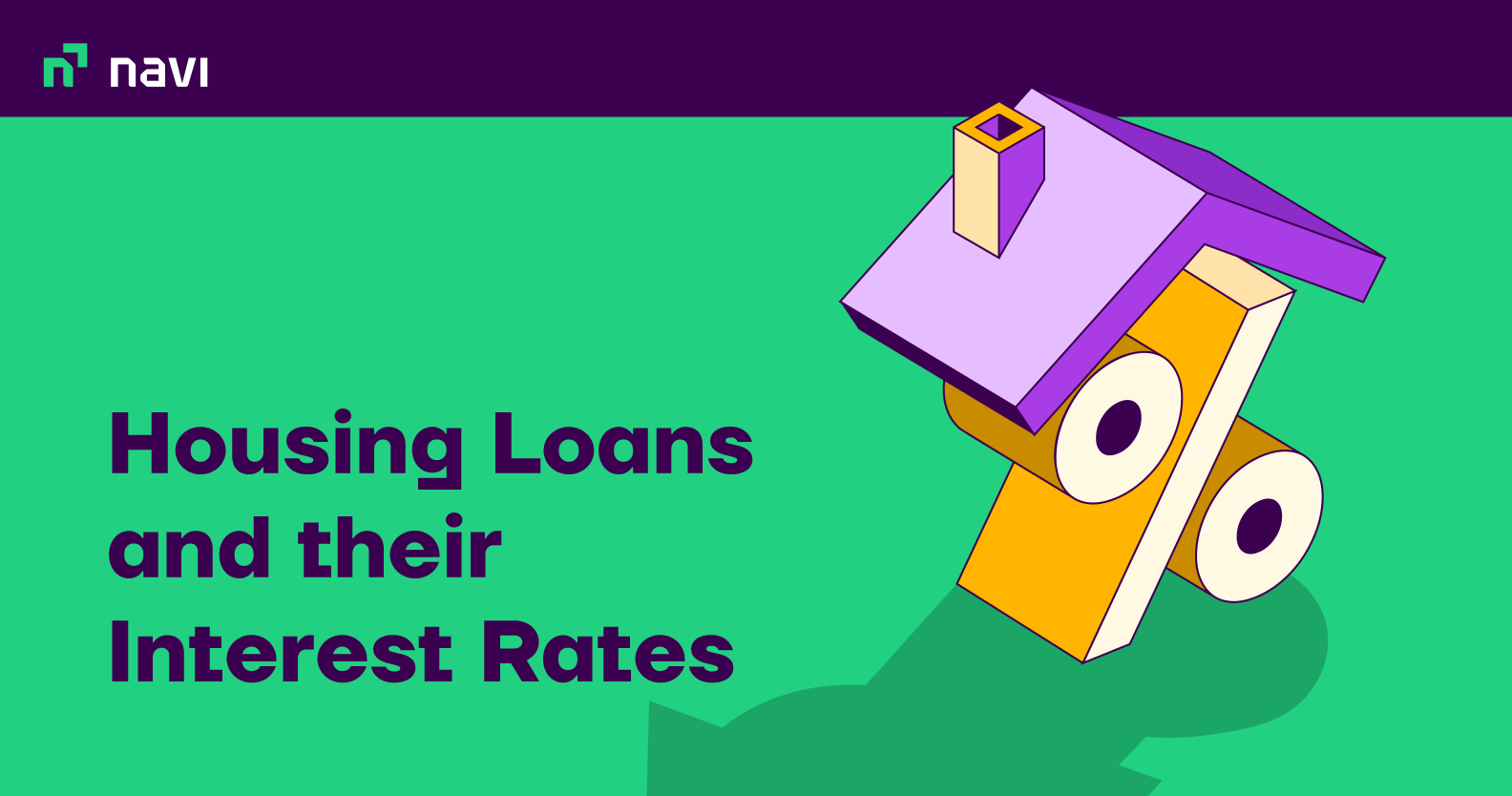Home Loan Interest Rates in India 2023 – EMI and Charges

With RBI increasing its repo rate to 6.50%, lenders have increased their home loan interest rates too. So, in case you are planning to apply for a home loan, check the latest home loan interest rates in 2023 to compare the rates offered by different lenders. This would help you make an informed decision. We have curated the top 10 home loan interest rates in India and have explained the factors that could affect your home loan interest rate so that you can make an informed decision. Let’s dive in!
Did You Know?
On 8 February 2023, the RBI increased its repo rate to 6.50%. This was the 6th time RBI hiked the repo rate in a span of less than 1 year. The move was attributed to combating inflation.
Current Home Loan Interest Rates in India (2023)
Refer to the table below to know the latest housing loan interest rates.
| Lender | Interest Rate (p.a.) | Processing Fee |
| Navi Home Loan | 8.45% onwards | No Processing Fee |
| LIC Housing Finance | 8.65% onwards | Up to 0.5% of the loan amount |
| Federal Bank | 10.15% onwards | Up to 0.5% of the loan amount |
| Tata Capital | 8.95% onwards | 0.50% of the home loan amount |
| HDFC Home Loan | 8.45% onwards* | 0.50% of the loan amount |
| Indian Overseas Bank | 9.55% onwards | 0.50% of the loan amount |
| IDBI | 8.80% onwards | 0.50% of the loan amount |
| HSBC | 8.69% onwards | 1% of the loan amount |
| SBI | 9.15% onwards | 0.35% of the loan amount and above |
| PNB Housing Finance | 8.50% onwards | 0.50% of the loan amount |
Navi Home Loan interest rates are pegged to the RBI repo rate and are subject to change as per RBI’s key policy changes.
Check Your Home Loan Eligibility
Loan Amount
Rate of Interest (P.a)
%
Loan Tenure (Years)
Years
Monthly EMI
0
Total Interest
Total Amount
Detailed Overview of Home Loan Interest Rates 2023
1. Navi Home Loan
Navi offers instant approval on home loans up to ₹5 crore at attractive interest rates. You can get up to 90% of the property value as a home loan with Navi. The best part is the application process is 100% paperless. All you need to do is download the Navi app, enter personnel and property details to check your pre-approved offer.
- Interest Rate: 8.45% p.a. onwards
- Eligibility Criteria
- Age: 25 – 62
- Nationality: Indian resident
- Type of Employment: Salaried
- Processing Fee: Nil
- Loan Tenure: Up to 30 years
2. LIC Housing Finance
LIC Housing Finance is an HFC (Housing Finance Company) that deals with a slew of home loan products, including regular home loan, plot loan, home improvement loan, and home loan for NRI, among others. LIC HF also offers balance transfer facilities through which you can transfer your existing loan account to LIC Housing Finance.
- Interest Rate for Salaried: 8.65% p.a. onwards
- Interest Rate for Self-employed: 8.75% p.a. onwards
- Eligibility Criteria
- Age: 21 – 65
- Nationality: Indian resident
- Type of Employment: Salaried or self-employed
- Processing Fee: Up to 0.50% of the loan amount
- Loan Tenure: Up to 30 years
3. Federal Bank Home Loan
Federal Bank offers home loans up to 85% of the actual property value. The bank also offers loans via overdraft facilities. In case you need money for home-related or personal use, you can take a top up home loan with Federal Bank – top up home loans don’t come with any end-use restrictions.
- Interest Rate for Salaried: 10.15% p.a. onwards
- Interest Rate for Self-employed: 10.20% p.a. onwards
- Eligibility Criteria
- Age: 21 – 65
- Nationality: Indian resident
- Type of Employment: Salaried or self-employed
- Processing Fee: Up to 0.50% of the loan amount
- Loan Tenure: Up to 30 years
4. Tata Capital Home Loan
Tata Capital offers home loans up to ₹5 crore at competitive interest rates. The NBFC (Non Banking Financial Company) claims to provide instant approval on home loans with minimal documentation.
- Interest Rate for Salaried: 8.95% p.a. onwards
- Interest Rate for Self-employed: 8.95% p.a. onwards
- Eligibility Criteria
- Age: 24 – 65
- Nationality: Indian resident
- Type of Employment: Salaried or self-employed
- Minimum Salary: ₹30,000 (for salaried)
- Processing Fee: Up to 1% of the loan amount
- Loan Tenure: Up to 30 years
5. HDFC Home Loan
HDFC Ltd. is one of the leading housing finance companies in India offering a wide variety of home loan products. HDFC is also known to roll out special home loan offers from time to time. You can get home loans up to 90% of the property value with HDFC.
- Interest Rate for Salaried: 8.45% p.a. onwards (limited period offer)
- Interest Rate for Self-employed: 8.45% p.a. onwards(limited period offer)
- Eligibility Criteria
- Age: 21 – 65
- Nationality: Indian resident
- Type of Employment: Salaried or self-employed
- Processing Fee: Up to 0.5% of the loan amount
- Loan Tenure: Up to 30 years
6. Indian Overseas Bank Home Loan
Indian Overseas Bank offers Subha Gruha – a home loan product foraspiring homebuyers. You can get home loans of 75% to 90% of the property value with IOB. Currently, the bank is running a zero processing fee limited period offer.
- Interest Rate for Salaried: 9.55% p.a. onwards
- Interest Rate for Self-employed: 9.55% p.a. onwards
- Concessional Interest Rate for Women:8.60% p.a. onwards (valid till 31 March 2023)
- Eligibility Criteria
- Age: 21 – 55 (could be extended to 60 in special cases)
- Nationality: Indian resident
- Type of Employment: Salaried or self-employed
- Processing Fee: Up to 0.5% of the loan amount (waived off till 31 March 2023)
- Loan Tenure: Up to 30 years
7. IDBI Home Loan
IDBI offers home loans ranging from 75% to 90% of the propertyvalue. However, though the repayment tenure is up to 30 years for salaried professionals, the repayment tenure for non-salaried professionals is capped at 20 years.
- Interest Rate for Salaried: 8.80% p.a. onwards (limited period offer)
- Interest Rate for Self-employed: 8.80% p.a. onwards (limited period offer)
- Eligibility Criteria
- Age: 22 – 70
- Nationality: Indian resident
- Type of Employment: Salaried or self-employed
- Processing Fee: Up to 0.5% of the loan amount
- Loan Tenure: Up to 30 years
8. HSBC Home Loan
HSBC offers home loans up to ₹40 crore starting at 8.55% p.a. With flexible repayment tenures. The bank also offers home loans for NRIs. You can also avail of balance transfer facilities with HSBC.
- Interest Rate for Salaried: 8.69% p.a. onwards
- Interest Rate for Self-employed: 8.79% p.a. onwards
- Balance Transfer Interest Rate: 8.55% p.a.
- Eligibility Criteria
- Age: 21 – 65
- Nationality: Indian resident
- Type of Employment: Salaried or self-employed
- Processing Fee: Up to 1% of the loan amount
- Loan Tenure: Up to 25 years
9. SBI Home Loan
SBI is one of the biggest players in the home loan sector with 33% market share. The bank also offers 5 bps concession for women applicants. You can also get a home loan as an overdraft with SBI.
- Interest Rate for Salaried: 9.15% p.a. onwards
- Interest Rate for Self-employed: 9.15% p.a. onwards
- Eligibility Criteria
- Age: 18 – 70
- Nationality: Indian resident
- Type of Employment: Salaried or self-employed
- Processing Fee: Up to 0.35% of the loan amount
- Loan Tenure: Up to 30 years
10. PNB Housing Finance Home Loan
PNB offers home loans up to 90% of the cost of the property at attractive interest rates. The housing finance company also offers flexible repayment tenure of up to 30 years. You can also avail of other home loan products like Unnati Loan (low income home loan) and plot loan with PNB Housing Finance.
- Interest Rate for Salaried: 8.50% p.a. onwards
- Interest Rate for Self-employed Non-Professionals: 8.55% p.a. onwards
- Eligibility Criteria
- Age: 21 – 70
- Nationality: Indian resident
- Type of Employment: Salaried or self-employed
- Processing Fee: Up to 0.50% of the loan amount
- Loan Tenure: Up to 30 years
Also Read
Different Types of Home Loan Interest Rates
Generally, there are two types of interest rates offered by lenders – fixed and floating interest rates.
1. Fixed Interest Rates
For fixed home loan rates, the rate of interest charged on loans remains constant throughout the tenure of the loan. As such, these loans have constant EMIs allowing a borrower to pre-plan his/her repayment.
Fixed interest rates are ideal when you expect market rates to go up in the future. However, if the market interest regime goes down, you may have to pay higher interest, resulting in a higher EMI obligation.
Depending on the type of loan, interest rates may be fixed for the entire tenure or a part of it, as per the lender’s policies.
2. Floating Interest Rates
A loan under a floating regime has a home loan rate that keeps changing over the tenure of the loan. It varies with changes in market conditions and the underlying external benchmarks such as the Reserve Bank of India’s repo rates. When the interest rates rise, so does your loan repayment amount and vice versa.
The floating interest rate is made out of two components: index and spread. The index refers to the measure of interest rates based on the underlying benchmark like the repo rate. On the other hand, the spread is the extra amount charged by a financial institution to cover credit risks and profit markup.
For instance, if the underlying index is 6% and a financial institution decides on a spread of an additional 2%, the applicable lending rate will be 8%.
Floating interest rates are ideal when the market interest rates are declining. However, if the standard interest rates go up, so do the payable EMIs.
Factors that Affect Home Loan Interest Rates
The final rate offered to you is solely at the discretion of the lender. However, here are a few factors that could affect your interest rate.
1. Benchmark Rate of Lending
Financial institutions can have several types of benchmark lending rates. Most banks follow RBI’s repo rate as an external benchmark while all NBFCs use PLR (Prime Lending Rate) to determine their housing loan interest rates.
2. Credit Score
The credit score allows lenders to study the applicant’s past debt repayment records and overall creditworthiness. Having a high credit score means the borrower is more likely to repay his/her loan in time. Hence, the lender could charge them a lower housing loan interest rate. In case, your credit score is on the lower side of the spectrum, you can still improve your score by following the best practices.
3. Your Income
Lenders assume lower credit risks when their borrowers have a steady source of income. That’s why salaried applicants at a reputable company will often get better interest rates compared to self-employed individuals.
4. Location of Property
The location, age, condition, and available amenities of the property also determine its resale value and, thus, the interest on a mortgage loan. A high resale value makes a property lucrative for lending institutions, often leading them to offer lower interest rates.
How to Calculate Home Loan Interest Rates?
Following are the different methods of calculating the interest rate of a home loan:
1. Flat Rate Method
In this method, one calculates the interest rate on the original principal amount. For example, if one borrows a home loan with a tenure of 20 years, he/she will pay a fixed interest rate for the entire tenure.
With this flat rate method, one could calculate the EMI using the following formula:
- EMI = (Principal + Total interest)/ loan tenure in months.
2. Reducing Balance Method
This method calculates the interest rate on the outstanding amount only. With the reducing balance method, interest is not charged on the principal component already paid with EMIs. As a result, the outstanding balance reduces with time.
One could calculate the EMI under this reducing balance method with the following formula.
- EMI = [P x r x (1+r)^n]/[(1+r)^n-1]
Here, P is the principal, r is the rate of interest, and n is the number of instalments.
3. Using a Home Loan Calculator
Financial institutions have their own EMI calculators that facilitate easy calculation of EMIs and a detailed breakdown of interest payments. You can take the help of Navi’s home Loan EMI calculator to calculate your monthly and yearly EMIs. Simply enter the loan amount, interest rate, and tenure, and you will get the EMI value.
4. Using Excel
Calculating home loan interest rates using Excel is simple and easy. You will need a formula and the values of its attributes.
The formula to use in Excel is as follows:
- = RATE (PMT, NPER, PV)
This is called the RATE function in Excel. Here, Rate stands for the home loan interest rate. NPER stands for the number of instalments, and PV stands for the principal amount or present value.
You need to enter these values to get your result. You should remember to enter the currency symbol when entering the loan value and the percentage symbol while entering the rate of interest. If you are calculating the interest rate, you will get the result in the percentage format.
How to Calculate Effective Interest Rate?
Effective interest rate, also known as effective annual interest rate, is the actual interest rate on a loan after considering the method of compounding. The rate of interest is equally proportionate to the frequency of the compounding period.
Effective Interest Rate Formula:
The following formula is used to compute the effective annual interest rate (EAR) on a loan:
- EAR= (1 + i/n)n – 1
where “i” stands for the annual interest rate & “n” is the frequency or number of compounding periods.
Also Read
Tips to Get Lower Interest Rates on Home Loans
Take a look at some tips and tricks you can follow to avail of lower interest rates on home loans:
- Maintain a good cibil score, preferably 750 or above, to get the most favourable interest rates.
- You can avail of a joint home loan with your spouse to get a lower interest rate.
- If your current lender charges higher interest rates, you can opt for a home loan balance transfer with another lender offering a lower interest rate.
Other Fees and Charges to Consider
Availing of a home loan often involves payment of various fees and charges.
1. Processing Fees
All financial institutions will charge a small processing fee, sometimes called an administrative fee, to process your loan application. This amount usually varies from 0.25% to 2% of the loan amount or up to Rs. 10,000.
2. Other Loan-related Fees
This includes pre-payment charges, application fees, late payment fees, conversion charges or switching fees, collection charges and insurance premiums.
3. Document-related Fees
This can include NOC charges, stamp duty fees, income tax certificate fees, fees for revalidation of NOC, CIBIL Report fees, etc. However, with financial institutions like Navi, you can minimise your cost of borrowing with zero documentation charges.
4. Legal Charges
This will likely include legal expenses, valuation fees, MoD of title deed charges, CERSAI charges, etc.
Final Word
When looking for a home loan, you should consider the lowest home loan interest rates, the least fees and charges, and the ease of the loan process. You should always do a thorough research of the lender, compare different loan offers, and read all the terms and conditions carefully before signing up.
Get your dream house without any second thoughts! Get Navi Home Loan in a 100% paperless manner, zero processing fees and at affordable rates. Download the Navi App to explore more!
FAQs
Repo rate is the interest the Reserve Bank of India charges from the banks while lending money. RBI supplies the funds to the banks for the loans we take as borrowers. So, the interest rates that we have to pay are simply the reflection of the interest rate the banks have to pay to the RBI. Hence, an increase or decrease in the Repo rate has a directly proportional effect on the home loan interest rate.
Most lenders usually provide loans with two types of rates – fixed interest rate and floating interest rate, which is slightly lesser than the fixed one. The preference depends on the borrower. If you are comfortable with the fickleness of the floating interest rate, you could benefit from that; otherwise, you should go with a fixed interest rate.
To check the total interest payout for your housing loan, you have to subtract the principal amount of your loan from the total repayment amount. This value is mostly accurate but can vary slightly.
Yes, your credit score will have some form of impact on your home loan interest rate. Even if a home loan is a secured loan, lenders take your credit score into consideration before approving a loan. Chances are the better your credit rating, the lower will be your interest rate. Usually, a credit score of more than or equal to 700 will get you the lowest interest rate.
The home loan interest rate is the percentage of the amount charged by the lender on the home loan. So, if you have a home loan of Rs.30 lakh and the interest rate is 8% p.a., you have to pay the additional amount every month in the form of EMI towards the principal amount as interest.
You can get the lowest home loan interest rate depending on the following parameters – credit score above 750, stable source of monthly income preferable above Rs.50,000, your relationship with the lender, and repayment capacity, to name a few. However, the final rate will be decided by the lender upon evaluation.
No. Financial institutions offer different interest rates and loan amounts depending on the credit risk and eligibility of an individual borrower among other factors.
To get a home loan, an applicant needs to be within a certain age bracket, usually 21 to 65 years, during the tenure. They will also need to have a steady source of income that can easily cover the home loan EMIs. A credit score over 750 is also desirable to get the best available loan rates.
To apply for a home loan with Navi, simply download the Navi app from Google Play or App Store. Then submit the property details, check eligibility with PAN and other basic details and get instant approval.
Before you go…
Are you looking to buy that house you’ve been eyeing 🏠 and you need a loan of up to ₹5 crore. Install the Navi app now and get instant in-principle approval right away! Interest rates starting at 8.60% p.a.
Disclaimer: This article has been prepared on the basis of internal data, publicly available information and other sources believed to be reliable. The information contained in this article is for general purposes only and not a complete disclosure of every material fact. It should not be construed as investment advice to any party. The article does not warrant the completeness or accuracy of the information, and disclaims all liabilities, losses and damages arising out of the use of this information. Readers shall be fully liable/responsible for any decision taken on the basis of this article.
Home Loan Knowledge Base
Explore Home Loan Offers in Your City

HSBC Bank Home Loan Interest Rate April 2023
HSBC offers a variety of home loan products designed for Indian citizens and NRIs (Non-Resident Ind... Read More »Axis Bank Home Loan Interest Rate April 2023
Axis Bank home loan interest rate starts at 8.75% p.a. The bank offers home loans up to ₹5 crore ... Read More »Karnataka Bank Home Loan Interest Rate April 2023
Karnataka Bank home loan interest rate starts at 9.26% p.a. The bank offers an array of home loan s... Read More »BBMP Property Tax – How to Calculate, Check Status and Pay Tax?
The Karnataka State Government imposes this tax on the residents of the State who own properties in... Read More »Union Bank of India Home Loan Interest Rate April 2023
Union Bank of India offers up to 90% of the property value as home loan. Union Bank home loan inter... Read More »Hartalika Teej in India 2023 – Muhurat and Rituals (18th Sept)
Hartalika Teej is an auspicious festival for Hindu women. The day is mainly dedicated to Goddess Pa... Read More »Bank of Baroda Home Loan Interest Rate April 2023
Bank of Baroda (BoB) home loan interest rate starts at 9.15% p.a. For the salaried and 9.25% ... Read More »Stamp Duty in Thane 2023 – Property Registration Charges
In India, every State government levies a stamp duty on property transfers. The location, type of p... Read More »Stamp Duty in Karnataka 2023 – Property Registration Charges
If you have recently purchased a property in Karnataka, you are liable to pay stamp duty in Karnata... Read More »Stamp Duty and Property Registration Charges in Telangana
The state government in India is in charge of defining rules and standards and managing the collect... Read More »Stamp Duty and Property Registration Charges in Pune
Stamp duty and registration charges need to be paid to the state government to register your proper... Read More »Apply for EC Online in Karnataka 2023 – Fees and Charges
The Government of Karnataka has introduced an online service portal (the Kaveri Online Services por... Read More »Top 10 Chit Fund Schemes in India in 2023
Chit funds are one of the most popular return-generating saving schemes in India. It is a financial... Read More »10 Best Gold ETFs in India to Invest in April 2023
Gold ETFs or Gold Exchange Traded Funds are passively managed funds that track the price of physica... Read More »10 Best Demat Accounts in India for Beginners in 2023
Creation of Demat accounts revolutionised the way trades were conducted at the stock exchanges. It... Read More »20 Best Index Funds to Invest in India in April 2023
What is an Index Fund? An index fund is a type of mutual fund or exchange-traded fund (ETF) that... Read More »Best Arbitrage Mutual Funds to Invest in India in April 2023
Arbitrage funds are hybrid mutual fund schemes that aim to make low-risk profits by buying and sell... Read More »10 Best SIP Plans in India to Invest in April 2023
What is SIP? SIP or Systematic Investment Plan is a method of investing a fixed amount in ... Read More »10 Best Corporate Bond Funds in India to Invest in April 2023
Corporate bond funds are debt funds that invest at least 80% of the investment corpus in companies ... Read More »10 Best Bank for Savings Account in India [Highest Interest Rate 2023]
Savings account is a type of financial instrument offered by several banks. It lets you safely depo... Read More »


































